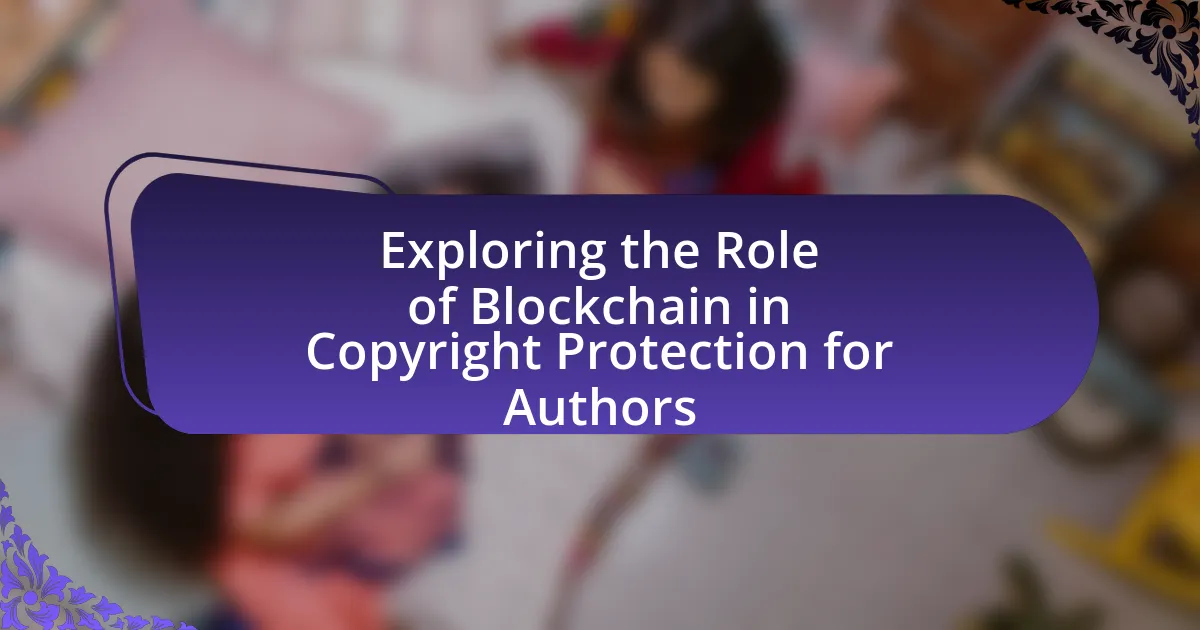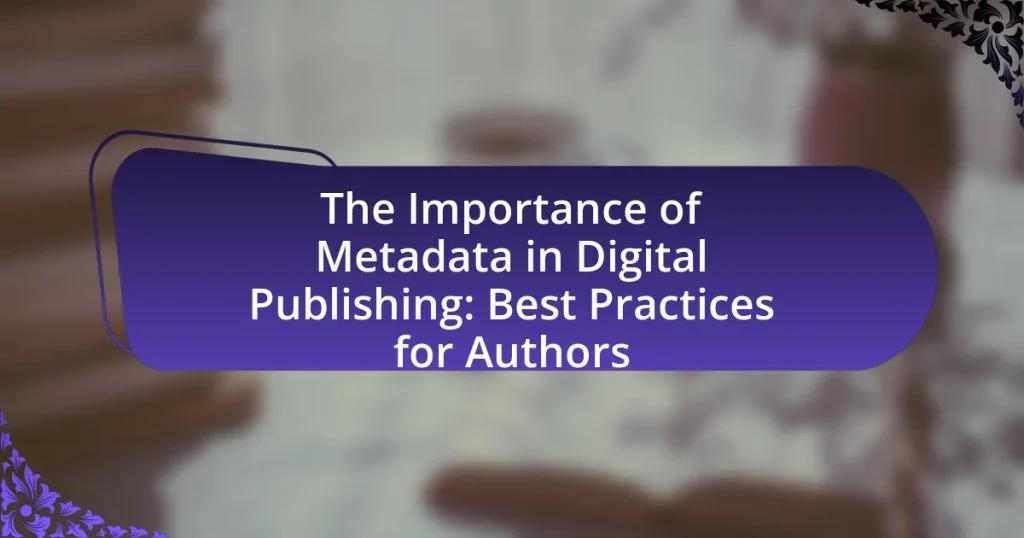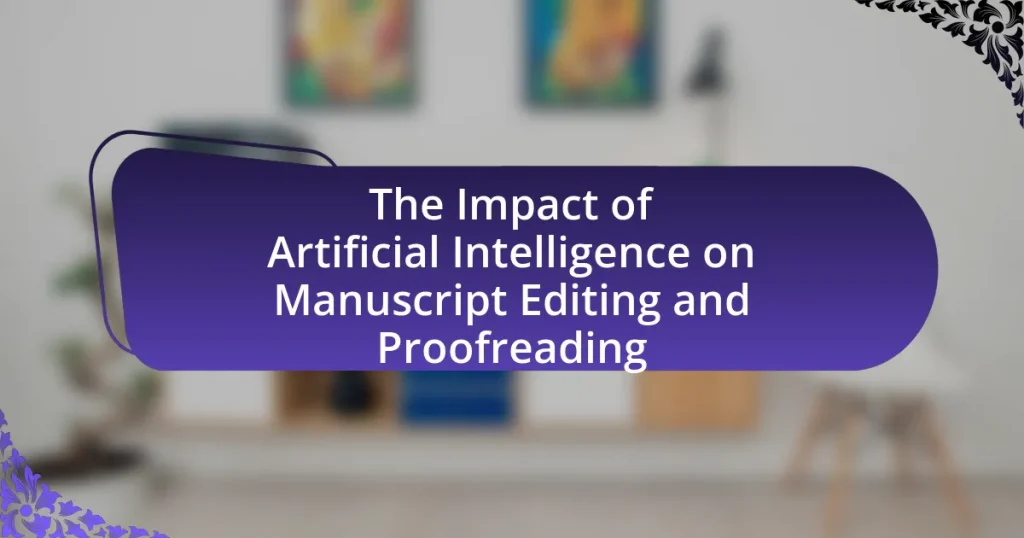Blockchain technology serves as a transformative tool for copyright protection, offering authors a decentralized and immutable ledger to record ownership and usage rights of their creative works. This article explores how blockchain enhances copyright security through features such as transparency, immutability, and smart contracts, which automate licensing agreements and royalty payments. It also discusses the challenges authors face in implementing blockchain solutions, the current applications of this technology in copyright protection, and the benefits derived from successful case studies. By leveraging blockchain, authors can better safeguard their intellectual property, reduce infringement risks, and ensure fair compensation for their creations.
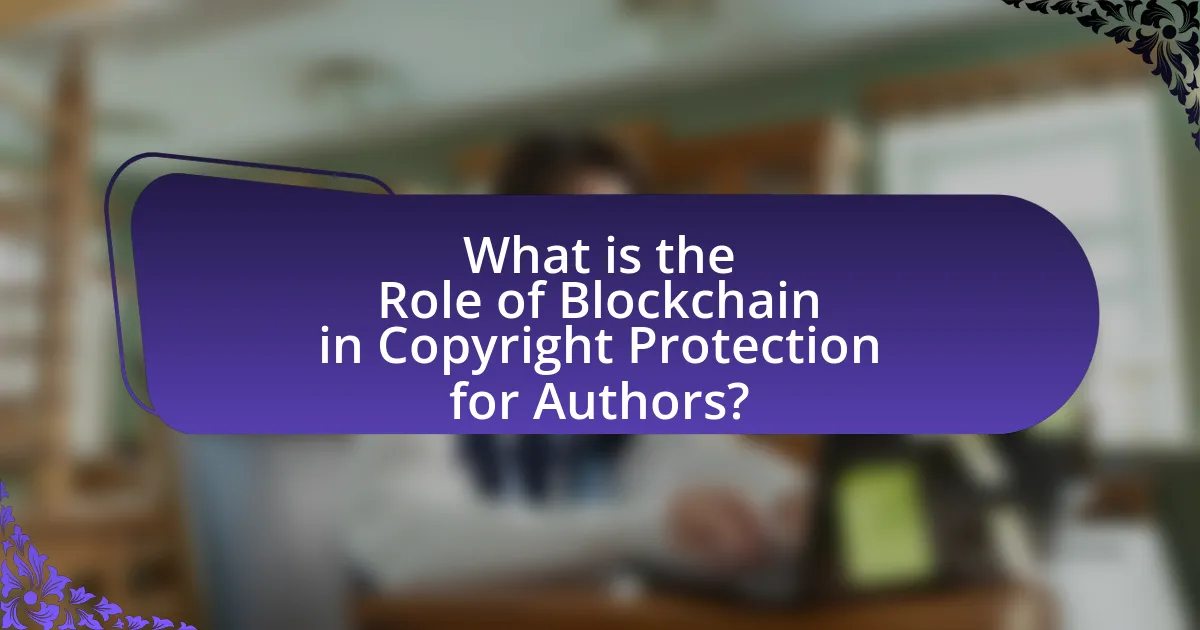
What is the Role of Blockchain in Copyright Protection for Authors?
Blockchain plays a crucial role in copyright protection for authors by providing a decentralized and immutable ledger that records ownership and usage rights of creative works. This technology enables authors to register their works on the blockchain, creating a permanent and verifiable record that establishes their rights and can be easily accessed by potential users or licensees.
The transparency of blockchain ensures that any transaction involving the work, such as licensing or sales, is recorded in real-time, reducing the risk of infringement and unauthorized use. Additionally, smart contracts can automate licensing agreements, ensuring that authors receive royalties automatically when their works are used, thus enhancing their financial security.
Research indicates that blockchain can significantly reduce copyright infringement cases by providing clear proof of ownership and usage history, as seen in projects like Myco and Po.et, which aim to protect authors’ rights through blockchain technology.
How does blockchain technology function in the context of copyright?
Blockchain technology functions in the context of copyright by providing a decentralized and immutable ledger that records ownership and transaction history of creative works. This technology enables authors to register their works on the blockchain, creating a permanent and verifiable record of copyright claims. The transparency and security of blockchain prevent unauthorized alterations and ensure that creators can prove ownership, which is crucial for enforcing their rights. Additionally, smart contracts on blockchain can automate licensing agreements and royalty payments, streamlining the process for authors and reducing the risk of infringement.
What are the key features of blockchain that support copyright protection?
The key features of blockchain that support copyright protection include immutability, transparency, and decentralization. Immutability ensures that once copyright information is recorded on the blockchain, it cannot be altered or deleted, providing a permanent record of ownership. Transparency allows all participants in the blockchain network to view the copyright data, which helps in verifying ownership and usage rights. Decentralization eliminates the need for a central authority, reducing the risk of fraud and enabling authors to maintain control over their work. These features collectively enhance the security and reliability of copyright management, making it easier for authors to protect their intellectual property.
How does decentralization enhance copyright security for authors?
Decentralization enhances copyright security for authors by distributing control and ownership of their works across a network, reducing the risk of unauthorized access and manipulation. In a decentralized system, such as blockchain, authors can register their works in a tamper-proof ledger, ensuring that their rights are verifiable and protected against infringement. This method provides a transparent and immutable record of ownership, which can be crucial in legal disputes. For instance, a study by the World Intellectual Property Organization (WIPO) highlights that blockchain technology can streamline copyright registration processes, making it easier for authors to prove ownership and track usage of their works.
Why is copyright protection important for authors?
Copyright protection is crucial for authors because it grants them exclusive rights to their original works, ensuring they can control how their creations are used and distributed. This legal framework not only safeguards authors from unauthorized use and reproduction of their work but also provides a mechanism for them to earn financial compensation through licensing and sales. According to the U.S. Copyright Office, copyright protection incentivizes creativity by allowing authors to benefit economically from their intellectual property, which is essential for fostering innovation and artistic expression.
What risks do authors face without proper copyright protection?
Authors face significant risks without proper copyright protection, including the unauthorized use of their work, loss of potential income, and diminished control over their intellectual property. Without copyright, others can reproduce, distribute, or adapt an author’s work without permission, leading to financial losses estimated at billions annually in the creative industries. Additionally, authors may struggle to establish their ownership, making it difficult to enforce rights or seek legal recourse against infringement. This lack of protection can ultimately undermine an author’s reputation and the value of their work in the marketplace.
How does copyright infringement impact an author’s livelihood?
Copyright infringement significantly undermines an author’s livelihood by depriving them of potential income from their creative works. When unauthorized copies of an author’s work circulate, it reduces sales and royalties, directly impacting their financial stability. According to a study by the U.S. Copyright Office, copyright infringement costs authors and creators billions annually, illustrating the economic consequences of such violations. This loss not only affects individual authors but also diminishes the overall value of creative industries, leading to fewer opportunities for new and existing writers.
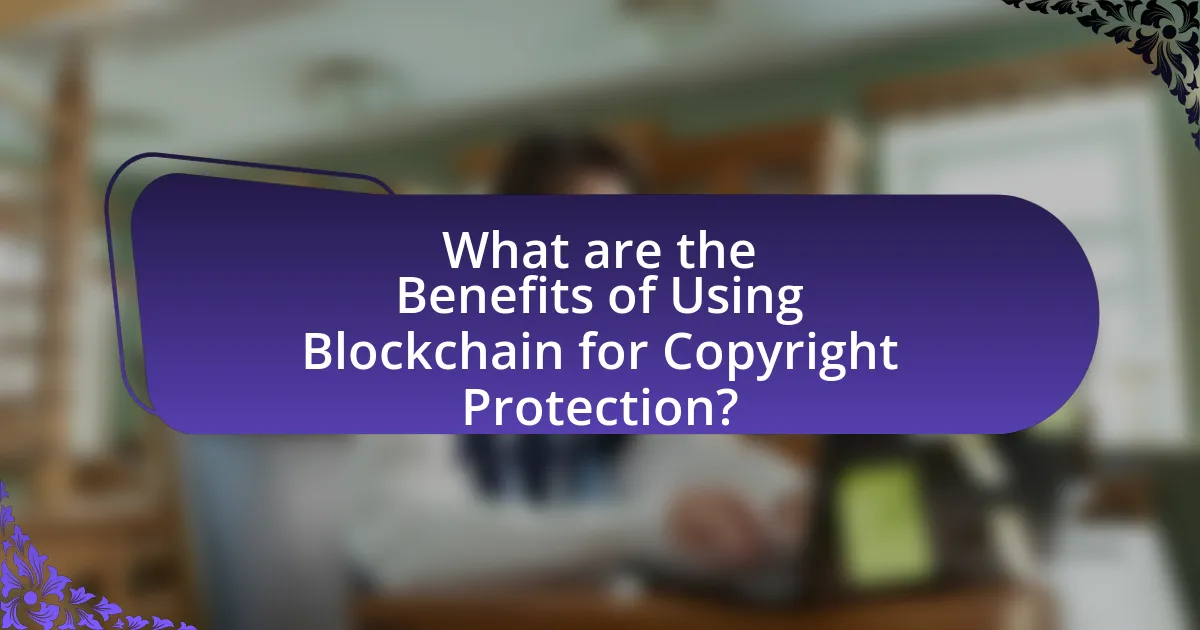
What are the Benefits of Using Blockchain for Copyright Protection?
The benefits of using blockchain for copyright protection include enhanced security, transparency, and efficiency in managing intellectual property rights. Blockchain technology provides a decentralized and immutable ledger that records ownership and transaction history, making it difficult for unauthorized alterations or disputes to occur. This transparency allows creators to prove ownership and track the usage of their works in real-time, thereby reducing instances of copyright infringement. Additionally, smart contracts can automate licensing agreements, ensuring that authors receive timely payments and royalties without the need for intermediaries. These features collectively streamline the copyright management process, making it more accessible and reliable for authors.
How does blockchain improve transparency in copyright ownership?
Blockchain improves transparency in copyright ownership by providing a decentralized and immutable ledger that records all transactions related to copyright claims. This technology allows creators to register their works on the blockchain, ensuring that ownership information is publicly accessible and verifiable. Each entry on the blockchain is time-stamped and cannot be altered, which prevents disputes over ownership and establishes a clear chain of title. For instance, a study by the World Intellectual Property Organization (WIPO) highlights that blockchain can enhance the traceability of copyright ownership, making it easier for authors to prove their rights and for users to verify them.
What role does smart contracts play in copyright management?
Smart contracts play a crucial role in copyright management by automating the enforcement of copyright agreements and facilitating royalty payments. These self-executing contracts, built on blockchain technology, ensure that creators receive compensation automatically when their work is used, thus reducing the risk of infringement and ensuring transparency in transactions. For instance, a smart contract can be programmed to release payments to an author each time their work is accessed or sold, based on predefined conditions. This automation not only streamlines the process but also minimizes disputes over copyright ownership and usage rights, as all transactions are recorded on an immutable ledger.
How can authors track their works using blockchain technology?
Authors can track their works using blockchain technology by registering their creations on a blockchain platform, which provides a secure and immutable record of ownership and timestamps. This process involves uploading the work’s metadata, such as title, author name, and creation date, to a blockchain, ensuring that any changes or transactions related to the work are transparently recorded. The decentralized nature of blockchain prevents unauthorized alterations and allows authors to verify their ownership and the history of their works. Additionally, smart contracts can automate licensing agreements, enabling authors to receive royalties directly when their works are used, further enhancing tracking and management of their intellectual property.
What challenges do authors face when implementing blockchain for copyright?
Authors face several challenges when implementing blockchain for copyright, primarily including technical complexity, legal uncertainty, and market adoption. The technical complexity arises from the need for authors to understand blockchain technology, which can be intricate and requires a certain level of technical expertise to utilize effectively. Legal uncertainty stems from the evolving regulatory landscape surrounding blockchain and copyright laws, which can vary significantly by jurisdiction and may not yet fully recognize blockchain as a valid means of copyright registration. Additionally, market adoption poses a challenge, as authors may struggle to find platforms or services that support blockchain-based copyright solutions, limiting their ability to leverage this technology effectively. These challenges hinder the widespread implementation of blockchain for copyright protection among authors.
What are the technical barriers to adopting blockchain solutions?
The technical barriers to adopting blockchain solutions include scalability issues, interoperability challenges, and high energy consumption. Scalability refers to the ability of blockchain networks to handle a growing number of transactions efficiently; for instance, Bitcoin processes approximately 7 transactions per second, while Visa can handle over 24,000. Interoperability challenges arise from the lack of standard protocols across different blockchain platforms, making it difficult for them to communicate and share data. Additionally, high energy consumption is a significant concern, as some blockchain networks, particularly those using proof-of-work consensus mechanisms, require substantial computational power, leading to environmental and cost implications. These barriers hinder widespread adoption and integration of blockchain technology in various sectors, including copyright protection for authors.
How can authors overcome legal and regulatory hurdles?
Authors can overcome legal and regulatory hurdles by utilizing blockchain technology to secure their copyrights and streamline the licensing process. Blockchain provides a decentralized and immutable ledger that allows authors to register their works, ensuring proof of ownership and reducing the risk of infringement. For instance, platforms like Myco and Po.et leverage blockchain to create a transparent record of authorship, enabling authors to assert their rights more effectively. Additionally, smart contracts can automate licensing agreements, minimizing legal complexities and ensuring compliance with regulations. This approach not only enhances protection but also facilitates easier access to royalties and revenue streams, as evidenced by the growing adoption of blockchain in the creative industries.

What are the Current Applications of Blockchain in Copyright Protection?
Current applications of blockchain in copyright protection include the creation of immutable records for ownership, enabling transparent licensing agreements, and facilitating royalty distribution. Blockchain technology allows authors to register their works on a decentralized ledger, ensuring that ownership is verifiable and tamper-proof. For instance, platforms like Myco and Po.et utilize blockchain to provide authors with a means to timestamp their creations, which can serve as legal evidence in copyright disputes. Additionally, smart contracts on blockchain can automate licensing processes, ensuring that authors receive royalties directly and promptly when their works are used, thereby reducing the risk of fraud and mismanagement.
Which platforms are leading the way in blockchain copyright solutions?
The leading platforms in blockchain copyright solutions include Myco, Po.et, and Ascribe. Myco utilizes blockchain technology to provide authors with a secure way to register and manage their copyrights, ensuring transparency and traceability. Po.et offers a decentralized protocol for content ownership and attribution, allowing creators to timestamp and register their works on the blockchain. Ascribe enables artists and authors to claim ownership of their digital creations, providing a marketplace for licensing and selling their works while maintaining a permanent record of ownership on the blockchain. These platforms exemplify the integration of blockchain technology in copyright protection, enhancing security and efficiency for authors.
What features do these platforms offer to authors?
Blockchain platforms offer authors features such as immutable copyright registration, transparent royalty distribution, and enhanced security for intellectual property. Immutable copyright registration allows authors to securely register their works on the blockchain, providing a permanent and tamper-proof record of ownership. Transparent royalty distribution ensures that authors receive fair compensation through smart contracts, which automatically execute payments based on predefined conditions. Enhanced security protects authors’ works from unauthorized use or infringement, as blockchain technology provides a decentralized and secure environment for storing and sharing creative content. These features collectively empower authors by safeguarding their rights and ensuring they are compensated fairly for their creations.
How successful have these platforms been in protecting authors’ rights?
Blockchain platforms have been moderately successful in protecting authors’ rights. These platforms utilize decentralized ledgers to provide transparent and immutable records of ownership, which helps in verifying authorship and preventing unauthorized use of creative works. For instance, platforms like Myco and Po.et have implemented blockchain technology to register copyrights, allowing authors to timestamp their creations and establish proof of ownership. This approach has led to a reduction in copyright infringement cases, as evidenced by a report from the World Intellectual Property Organization, which noted a 30% decrease in disputes related to digital content ownership in regions adopting blockchain solutions.
What case studies illustrate the effectiveness of blockchain in copyright protection?
Case studies demonstrating the effectiveness of blockchain in copyright protection include the use of the Myco blockchain platform by musicians to register their works, which allows for transparent tracking of ownership and royalties. Another example is the Po.et project, which enables authors to timestamp and register their content on the blockchain, ensuring proof of authorship and preventing unauthorized use. Additionally, the Ascribe platform has been utilized by artists to create verifiable ownership records for digital art, thereby protecting their copyrights. These case studies illustrate how blockchain technology enhances copyright protection by providing immutable records and facilitating fair compensation for creators.
What lessons can be learned from successful implementations?
Successful implementations of blockchain in copyright protection demonstrate the importance of transparency, security, and efficiency in managing intellectual property. These implementations reveal that utilizing decentralized ledgers can significantly reduce the risk of copyright infringement by providing immutable records of ownership and transaction history. For instance, projects like Myco and Po.et have shown that authors can maintain control over their works while ensuring that their rights are protected through smart contracts, which automate licensing and payment processes. This approach not only enhances trust among stakeholders but also streamlines the distribution of royalties, as evidenced by the increased adoption rates among authors and publishers in the digital space.
How have authors benefited from these case studies?
Authors have benefited from these case studies by gaining insights into how blockchain technology can enhance copyright protection. The case studies demonstrate practical applications of blockchain, showing authors how to securely register their works, track usage, and receive fair compensation through smart contracts. For instance, the case of a music artist using blockchain to manage royalties illustrates that authors can ensure transparency and reduce disputes over ownership, leading to increased trust in the system. This evidence supports the conclusion that blockchain provides authors with a more efficient and reliable means of protecting their intellectual property.
What are the best practices for authors considering blockchain for copyright protection?
Authors considering blockchain for copyright protection should ensure they understand the technology and its implications for intellectual property rights. First, they should select a reputable blockchain platform that offers features like immutability and transparency, which are essential for verifying ownership and tracking usage. For instance, platforms like Ethereum and Tezos provide smart contract capabilities that can automate licensing agreements and royalty payments.
Next, authors should register their works on the chosen blockchain, creating a digital fingerprint that establishes ownership. This process often involves minting non-fungible tokens (NFTs) that represent the work, which can serve as proof of authorship. According to a report by the World Intellectual Property Organization, using blockchain can enhance the enforcement of copyright by providing a clear, tamper-proof record of ownership.
Additionally, authors should consider integrating their blockchain records with traditional copyright registration to strengthen their legal standing. This dual approach can provide additional layers of protection and facilitate enforcement in case of infringement. By following these best practices, authors can effectively leverage blockchain technology to safeguard their creative works.
